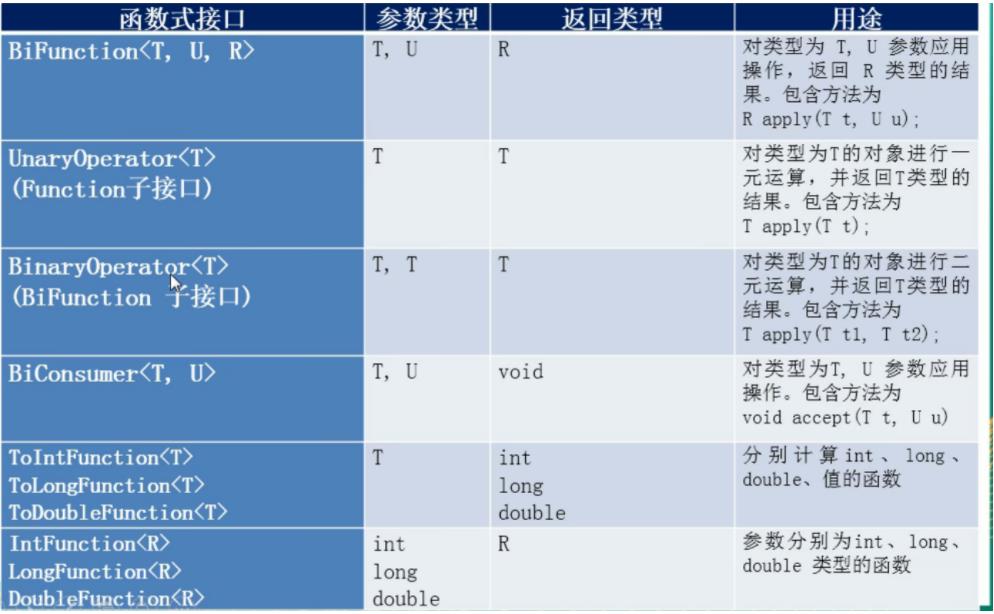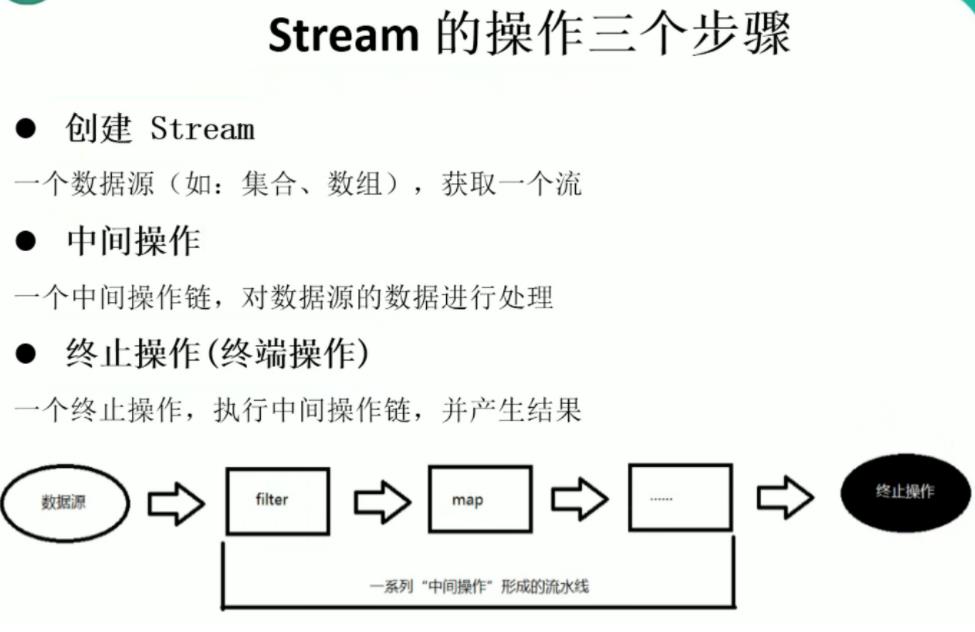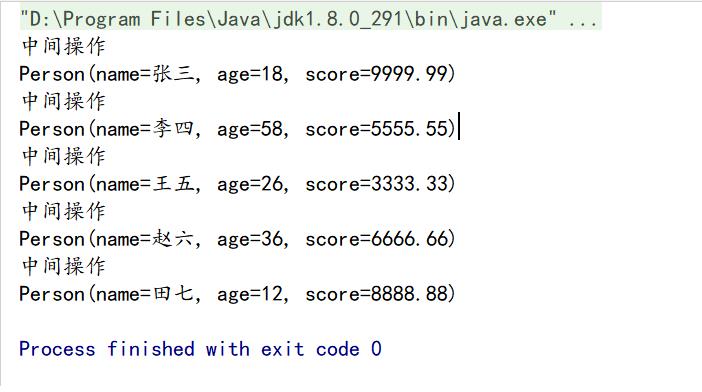Java8新特性:StreamAPI(超详解)
Posted _GGBond_
tags:
篇首语:本文由小常识网(cha138.com)小编为大家整理,主要介绍了Java8新特性:StreamAPI(超详解)相关的知识,希望对你有一定的参考价值。
Java8新特性:StreamAPI
- 前言
- 一、Stream API说明
- 二、为什么要使用Stream API?
- 三、什么是 Stream?
- 四、Stream 操作的三个步骤
- 五、创建Stream实例
- 六、Stream 的中间操作
- 七、Stream 的终止操作
前言
本博主将用CSDN记录软件开发求学之路上亲身所得与所学的心得与知识,有兴趣的小伙伴可以关注博主!
也许一个人独行,可以走的很快,但是一群人结伴而行,才能走的更远!让我们在成长的道路上互相学习,欢迎关注!
一、Stream API说明
- Stream API ( java.util.stream) 把真正的函数式编程风格引入到Java中。这是目前为止对Java类库最好的补充,因为Stream API可以极大提供Java程 序员的生产力,让程序员写出高效率、干净、简洁的代码。
- Stream 是 Java8 中处理集合的关键抽象概念,它可以指定你希望对集合进行的操作,可以执行非常复杂的查找、过滤和映射数据等操作。
使用 Stream API 对集合数据进行操作,就类似于使用 SQL 执行的数据库查询。也可以使用 Stream API来并行执行操作。简言之,Stream API 提供了一种高效且易于使用的处理数据的方式。
二、为什么要使用Stream API?
- 实际开发中,项目中多数数据源都来自于mysql,Oracle等。但现在数据源可以更多了,有MongDB,Radis等,而这些NoSQL的数据就需要Java层面去处理。
- Stream 和 Collection 集合的区别:Collection 是一种静态的内存数据结构,而 Stream 是有关计算的。前者是主要面向内存,存储在内存中,后者主要是面向 CPU,通过 CPU 实现计算。
三、什么是 Stream?
是数据渠道,用于操作数据源(集合、数组等)所生成的元素序列。
“集合讲的是数据,Stream讲的是计算!”
注意:
- Stream关注的是对数据的运算,与
CPU打交道,集合关注的是数据的存储,与内存打交道。- Stream 自己不会存储元素。
- Stream 不会改变源对象。相反,他们会返回一个持有结果的新Stream。
- Stream 操作是延迟执行的。这意味着他们会等到需要结果的时候才执行
四、Stream 操作的三个步骤
1、创建 Stream
一个数据源(如:集合、数组),获取一个流。
2、中间操作
一个中间操作链,对数据源的数据进行处理。
3、终止操作(终端操作)
一旦执行终止操作,就执行中间操作链,并产生结果,之后,不会再被使用。

⭕ 注意:
- 一个中间操作链,对数据源的数据进行处理
- 一旦执行终止操作,就执行中间操作链,并产生结果。之后,不会再被使用
五、创建Stream实例
1、创建 Stream方式一:通过集合
Java8 中的 Collection 接口被扩展,提供了两个获取流的方法:
| 方法 | 描述 |
|---|---|
default Stream<E> stream() | 返回一个顺序流 |
default Stream<E> parallelStream() | 返回一个并行流 |
代码演示:
//创建 Stream方式一:通过集合
@Test
public void test1()
List<Employee> employees = EmployeeData.getEmployees();
// default Stream<E> stream() : 返回一个顺序流
Stream<Employee> stream = employees.stream();
// default Stream<E> parallelStream() : 返回一个并行流
Stream<Employee> parallelStream = employees.parallelStream();
2、创建 Stream方式二:通过数组
Java8中的Arrays的静态方法stream()可以获取数组流:
| 方法 | 描述 |
|---|---|
static <T> Stream<T> stream(T[] array) | 返回一个流 |
public static IntStream stream(int[] array) | 返回一个 int 型流 |
public static LongStream stream(long[] array) | 返回一个 long 型流 |
public static DoubleStream stream(double[] array) | 返回一个 double 型流 |
代码演示:
//创建 Stream方式二:通过数组
@Test
public void test2()
int[] arr = new int[]1,2,3,4,5,6;
//调用Arrays类的static <T> Stream<T> stream(T[] array): 返回一个流
IntStream stream = Arrays.stream(arr);
Employee e1 = new Employee(1001,"Tom");
Employee e2 = new Employee(1002,"Jerry");
Employee[] arr1 = new Employee[]e1,e2;
Stream<Employee> stream1 = Arrays.stream(arr1);
3、创建 Stream方式三:通过Stream的of()
可以调用
Stream类静态方法of(), 通过显示值创建一个流。它可以接收任意数量的参数。
| 方法 | 描述 |
|---|---|
public static<T> Stream<T> of(T... values) | 返回一个流 |
代码演示:
//创建 Stream方式三:通过Stream的of()
@Test
public void test3()
Stream<Integer> stream = Stream.of(1, 2, 3, 4, 5, 6);
4、创建 Stream方式四:创建无限流
可以使用静态方法
Stream.iterate()和Stream.generate(), 创建无限流。
| 方法 | 描述 |
|---|---|
public static<T> Stream<T> iterate(final T seed, final UnaryOperator<T> f) | 迭代 |
public static<T> Stream<T> generate(Supplier<T> s) | 生成 |
代码演示:
//创建 Stream方式四:创建无限流
@Test
public void test4()
// 迭代
// public static<T> Stream<T> iterate(final T seed, final UnaryOperator<T> f)
//遍历前10个偶数
Stream.iterate(0, t -> t + 2).limit(10).forEach(System.out::println);
// 生成
// public static<T> Stream<T> generate(Supplier<T> s)
Stream.generate(Math::random).limit(10).forEach(System.out::println);
六、Stream 的中间操作
多个中间操作可以连接起来形成一个流水线,除非流水线上触发终止 操作,否则中间操作不会执行任何的处理!而在终止操作时一次性全
部处理,称为“惰性求值”。
1、筛选与切片
| 方 法 | 描 述 |
|---|---|
filter(Predicate p) | 接收 Lambda, 从流中排除某些元素 |
distinct() | 筛选,通过流所生成元素的 hashCode() 和 equals() 去除重复元素 |
limit(long maxSize) | 截断流,使其元素不超过给定数量 |
skip(long n) | 跳过元素,返回一个扔掉了前 n个元素的流。若流中元素不足 n个,则返回一个空流。与 limit(n) 互补 |
代码演示:
//1-筛选与切片
@Test
public void test1()
List<Employee> list = EmployeeData.getEmployees();
// filter(Predicate p)——接收 Lambda , 从流中排除某些元素。
Stream<Employee> stream = list.stream();
//练习:查询员工表中薪资大于7000的员工信息
stream.filter(e -> e.getSalary() > 7000).forEach(System.out::println);
System.out.println();
// limit(n)——截断流,使其元素不超过给定数量。
list.stream().limit(3).forEach(System.out::println);
System.out.println();
// skip(n) —— 跳过元素,返回一个扔掉了前 n 个元素的流。若流中元素不足 n 个,则返回一个空流。与 limit(n) 互补
list.stream().skip(3).forEach(System.out::println);
System.out.println();
// distinct()——筛选,通过流所生成元素的 hashCode() 和 equals() 去除重复元素
list.add(new Employee(1010,"刘强东",40,8000));
list.add(new Employee(1010,"刘强东",41,8000));
list.add(new Employee(1010,"刘强东",40,8000));
list.add(new Employee(1010,"刘强东",40,8000));
list.add(new Employee(1010,"刘强东",40,8000));
// System.out.println(list);
list.stream().distinct().forEach(System.out::println);
2、映 射
| 方法 | 描述 |
|---|---|
map(Function f) | 接收一个函数作为参数,该函数会被应用到每个元素上,并将其映射成一个新的元素。 |
mapToDouble(ToDoubleFunction f) | 接收一个函数作为参数,该函数会被应用到每个元素上,产生一个新的 DoubleStream。 |
mapToInt(ToIntFunction f) | 接收一个函数作为参数,该函数会被应用到每个元素上,产生一个新的 IntStream。 |
mapToLong(ToLongFunction f) | 接收一个函数作为参数,该函数会被应用到每个元素上,产生一个新的 LongStream。 |
flatMap(Function f) | 接收一个函数作为参数,将流中的每个值都换成另一个流,然后把所有流连接成一个流 |
代码演示:
//映射
@Test
public void test2()
// map(Function f)——接收一个函数作为参数,将元素转换成其他形式或提取信息,该函数会被应用到每个元素上,并将其映射成一个新的元素。
List<String> list = Arrays.asList("aa", "bb", "cc", "dd");
list.stream().map(str -> str.toUpperCase()).forEach(System.out::println);
// 练习1:获取员工姓名长度大于3的员工的姓名。
List<Employee> employees = EmployeeData.getEmployees();
Stream<String> namesStream = employees.stream().map(Employee::getName);
namesStream.filter(name -> name.length() > 3).forEach(System.out::println);
System.out.println();
//练习2:
Stream<Stream<Character>> streamStream = list.stream().map(StreamAPITest1::fromStringToStream);
streamStream.forEach(s ->
s.forEach(System.out::println);
);
System.out.println();
// flatMap(Function f)——接收一个函数作为参数,将流中的每个值都换成另一个流,然后把所有流连接成一个流。
Stream<Character> characterStream = list.stream().flatMap(StreamAPITest1::fromStringToStream);
characterStream.forEach(System.out::println);
//将字符串中的多个字符构成的集合转换为对应的Stream的实例
public static Stream<Character> fromStringToStream(String str)//aa
ArrayList<Character> list = new ArrayList<>();
for(Character c : str.toCharArray())
list.add(c);
return list.stream();
@Test
public void test3()
ArrayList list1 = new ArrayList();
list1.add(1);
list1.add(2);
list1.add(3);
ArrayList list2 = new ArrayList();
list2.add(4);
list2.add(5);
list2.add(6);
// list1.add(list2);
list1.addAll(list2);
System.out.println(list1);
3、排序
| 方法 | 描述 |
|---|---|
sorted() | 产生一个新流,其中按自然顺序排序 |
sorted(Comparator com) | 产生一个新流,其中按比较器顺序排序 |
代码演示:
//3-排序
@Test
public void test4()
// sorted()——自然排序
List<Integer> list = Arrays.asList(12, 43, 65, 34, 87, 0, -98, 7);
list.stream().sorted().forEach(System.out::println);
//抛异常,原因:Employee没有实现Comparable接口
// List<Employee> employees = EmployeeData.getEmployees();
// employees.stream().sorted().forEach(System.out::println);
// sorted(Comparator com)——定制排序
List<Employee> employees = EmployeeData.getEmployees();
employees.stream().sorted( (e1,e2) ->
int ageValue = Integer.compare(e1.getAge(),e2.getAge());
if(ageValue != 0)
return ageValue;
else
return -Double.compare(e1.getSalary(),e2.getSalary());
).forEach(System.out::println);
七、Stream 的终止操作
- 终端操作会从流的流水线生成结果。其结果可以是任何不是流的值,例 如:List、Integer,甚至是 void 。
- 流进行了终止操作后,不能再次使用。
1、匹配与查找
| 方法 | 描述 |
|---|---|
allMatch(Predicate p) | 检查是否匹配所有元素 |
anyMatch(Predicate p) | 检查是否至少匹配一个元素 |
noneMatch(Predicate p) | 检查是否没有匹配所有元素 |
findFirst() | 返回第一个元素 |
findAny() | 返回当前流中的任意元素 |
count() | 返回流中元素总数 |
max(Comparator c) | 返回流中最大值 |
min(Comparator c) | 返回流中最小值 |
forEach(Consumer c) | 内部迭代(使用 Collection 接口需要用户去做迭代,称为外部迭代。相反,Stream API 使用内部迭代——它帮你把迭代做了) |
代码演示:
//1-匹配与查找
@Test
public void test1()
List<Employee> employees = EmployeeData.getEmployees();
// allMatch(Predicate p)——检查是否匹配所有元素。
// 练习:是否所有的员工的年龄都大于18
boolean allMatch = employees.stream().allMatch(e -> e.getAge() > 18);
System.out.println(allMatch);
// anyMatch(Predicate p)——检查是否至少匹配一个元素。
// 练习:是否存在员工的工资大于 10000
boolean anyMatch = employees.stream().anyMatch(e -> e.getSalary() > 10000);
System.out.println(anyMatch);
// noneMatch(Predicate p)——检查是否没有匹配的元素。
// 练习:是否存在员工姓“雷”
boolean noneMatch = employees.stream().noneMatch(e -> e.getName().startsWith("雷"));
System.out.println(noneMatch);
// findFirst——返回第一个元素
Optional<Employee> employee = employees.stream().findFirst();
System.out.println(employee);
// findAny——返回当前流中的任意元素
Optional<Employee> employee1 = employees.parallelStream().findAny();
System.out.println(employee1);
@Test
public void test2()
List<Employee> employees = EmployeeData.getEmployees();
// count——返回流中元素的总个数
long count = employees.stream().filter(e -> e.getSalary() > 5000).count();
System.out.println(count);
// max(Comparator c)——返回流中最大值
// 练习:返回最高的工资:
Stream<Double> salaryStream = employees.stream().map(e -> e.getSalary());
Optional<Double> maxSalary = salaryStream.max(Double::compare);
System.out.println(maxSalary);
// min(Comparator c)——返回流中最小值
// 练习:返回最低工资的员工
Optional<Employee> employee = employees.stream().min((e1, e2) -> Double.compare(e1.getSalary(), e2.getSalary()));
System.out.println(employee);
System.out.println();
// forEach(Consumer c)——内部迭代
employees.stream().forEach(System.out::println);
Java8新特性,你一定能学会的超详细保姆级源码笔记,看完还不会请直接砍我
1. 新特性简介
新特性简介
-
速度更快
-
代码更少:新增了Lambda表达式
-
强大的Stream API
-
便于并行
-
最大化减少空指针异常Optional
2. Lambda表达式
介绍
Lambda是一个匿名函数,我们可以把Lambda表达式理解为是一段可以传递的代码(将代码像数据一样进行传递)。可以写出更简洁、更灵活的代码。作为一种更紧凑的代码风格,使Java的语言表达能力得到了提升。
基础语法
-
Java8引入了一个新的操作符: ->,该操作符称为箭头操作符或Lambda操作符,箭头操作符将Lambda表达式拆分为2部分
-
左侧:Lambda表达式的参数列表
-
右侧:Lambda表达式中所执行的功能,即Lambda体
-
语法格式1:无参数,无返回值:
() -> System.out.println( "hello world" );
public class test
public static void main(String[] args)
Runnable r = new Runnable()
@Override
public void run()
System.out.println("Hello World!");
;
r.run();
System.out.println("--------------------------------------");
Runnable r1 = () ->
System.out.println("Hello Lambda");
;
r1.run();
-
语法格式2:有一个参数,并且无返回值,小括号可省略不写,:
public class test
public static void main(String[] args)
Consumer<String> con = x ->
System.out.println(x);
;
con.accept("QWERTY");
-
语法格式3:有2个以上的参数,有返回值,并且Lambda体中有多条返回值
public class test
public static void main(String[] args)
Comparator<Integer> com = (x,y) ->
System.out.println("函数式接口");
return Integer.compare(x,y);
;
-
语法格式4:若Lambda体中只有一条语句,return和大括号都可省略不写
public class test
public static void main(String[] args)
Comparator<Integer> com = (x,y) -> Integer.compare(x,y);
-
语法格式5:Lambda表达式的参数列表的数据类型可以省略不写,因为JVM编译器通过上下文推断出数据类型,即“类型推断”
-
Lambda表达式需要函数式接口的支持!
函数式接口:接口中只有一个抽象方法的接口,称为函数式接口,可以使用@FunctionalInterface修饰
案例1:简单运算
-
函数式运算接口
@FunctionalInterface
public interface MyFun
Integer getValue(Integer num);
-
测试类
public class test
public static void main(String[] args)
Integer result = operation(10,x ->
return x * x;
);
System.out.println(result);
//operation方法,参数1为一Integer类型数据,参数2为一运算接口
public static Integer operation(Integer num, MyFun myFun)
return myFun.getValue(num);
案例2:定制排序比较两个Employee,先按年龄比,年龄相同再按姓名比,使用Lambda作为参数传递
-
Employee
@Data
@AllArgsConstructor
@NoArgsConstructor
public class Employee
private String name;
private int age;
private Double salary;
-
测试类
public class test
public static void main(String[] args)
List<Employee> list = Arrays.asList(
new Employee("1号", 25, 5000.0),
new Employee("2号", 35, 3000.0),
new Employee("3号", 35, 2000.0),
new Employee("4号", 35, 8000.0),
new Employee("5号", 65, 1000.0)
);
Collections.sort(list,(e1,e2)->
if (e1.getAge() == e2.getAge())
return e1.getName().compareTo(e2.getName());
else
return -Integer.compare(e1.getAge(),e2.getAge());
);
Iterator<Employee> iterator = list.iterator();
while (iterator.hasNext())
System.out.println(iterator.next());
3. 函数式接口
四大核心函数式接口
-
Consumer<T>:消费型接口
void accept(T t);
-
Supplier<T>:供给型接口
T get();
-
Function(T,R):函数型接口
R apply(T t);
-
Predicate<T>:断言型接口
boolean test(T t);
例子
-
Consumer<T>:消费型接口
@Test
public void test()
this.happy(1000,m ->
System.out.println("我消费了"+ m);
);
public void happy(double money, Consumer<Double> con)
con.accept(money);
-
Supplier<T>:供给型接口
@Test
public void test()
List<Integer> numList = this.getNumList(5, () -> (int) (Math.random() * 100));
for (Integer integer : numList)
System.out.println(integer);
//产生指定数量的整数
public List<Integer> getNumList(int num, Supplier<Integer> sup)
List<Integer> list = new ArrayList<>();
for (int i = 0; i < num; i++)
list.add(sup.get());
return list;
-
Function(T,R):函数型接口
@Test
public void test()
System.out.println(this.handler("str", str -> (str + "123")));
//处理字符串
public String handler(String str, Function<String,String> fun)
return fun.apply(str);
-
Predicate<T>:断言型接口
@Test
public void test()
List<String> stringList = Arrays.asList("qwe", "123", "hello", "ranhaifeng", "asdasdsaewqewqe");
List<String> list = filterStr(stringList, s -> (s.length() > 3));
for (String s : list)
System.out.println(s);
//将满足条件的字符串放入集合
public List<String> filterStr(List<String> list, Predicate<String> pre)
List<String> stringList = new ArrayList<>();
for (String s : list)
if (pre.test(s))
stringList.add(s);
return stringList;
其他接口

4. 方法引用与构造器引用
方法引用
-
方法引用:若 Lambda 体中的内容有方法已经实现了,我们可以使用“方法引用”,可以理解为方法引用是Lambda表达式的另外一种表现形式。
-
主要有三种语法格式:
对象::实例方法名类::静态方法名类::实例方法名
-
例子
//对象::实例方法
@Test
public void test()
Consumer<String> con = x ->
System.out.println(x);
;
PrintStream out = System.out;
Consumer<String> con1 = out::println;
Consumer<String> con2 = System.out::println;
con2.accept("qwe");
//类::静态方法名
@Test
public void test()
int x;int y;
Comparator<Integer> com = (x,y)-> Integer.compare(x,y);
Comparator<Integer> com1 = Integer::compare;
// 类::实例方法名
@Test
public void test()
BiPredicate<String,String> bp = (x,y) -> x.equals(y);
BiPredicate<String,String> bp2 = String::equals;
-
注意:
- Lambda体中调用方法的参数列表与返回值类型,要与函数式接口中抽象方法的函数列表和返回值类型保持一致!
- 若Lambda参数列表中的第一参数是实例方法的调用者,第二个参数是实例方法的参数时,可以使用
ClassName::method
构造器引用
-
例子
@Test
public void test()
Supplier<Object> sup = () -> new Object();
Supplier<Object> sup2 = Object::new;
//如果有多个构造器,如何判断是调用的实体类的哪个构造器呢?看下面的注意,即Function(T,R)内部的函数 R apply(T t) 是1个参数,那么就会调用是1个参数的构造器。
Function<Integer,Employee> fun2 =Employee::new;
-
注意:需要调用的构造器的参数列表要与函数式接口中抽象方法的参数列表保持一致!
数组引用
@Test
public void test()
Function<Integer,String[]> fun = x -> new String[x];
Function<Integer,String[]> fun2 = String[]::new;
5. Stream API
介绍
- Java8中有两大最为重要的改变。第一个是 Lambda 表达式;另外一个则是Stream API(java.util.stream.*)。Stream是 Java8中处理集合的关键抽象概念,它可以指定你希望对集合进行的操作,可以执行非常复杂的查找、过滤和映射数据等操作。使用Stream API 对集合数据进行操作,就类似于使用 SQL执行的数据库查询。也可以使用Stream API来并行执行操作简而言之,Stream API提供了一种高效且易于使用的处理数据的方式。
- 流(Stream)到底是什么呢?
是数据渠道,用于操作数据源(集合、数组等)所生成的元素序列。“集合讲的是致据遏进的是让算*”
注意: - 注意:
- Stream 自己不会存储元素。
- Stream不会改变源对象。相反,他们会返回一个持有结果的新Stream
- Stream操作是延迟执行的。这意味着他们会等到需要结果的时候才执行。

5.1 创建
Stream的创建
@Test
public void test()
//1.可以通过Collection系列集合提供的stream()或parallelstream()
List<String> list = Arrays.asList("1", "2", "3");
Stream<String> stream = list.stream();
//2.通过Arrays中的静态方法stream()获取数组流
int [] arr = new int[10];
IntStream stream1 = Arrays.stream(arr);
//3.通过Stream类中的静态方法of()
Stream<String> stream2 = Stream.of("1", "2", "3");
//4.创建无限流
//迭代
Stream<Integer> stream3 = Stream.iterate(0, x -> x + 2);
stream3.limit(10).forEach(System.out::println);
//生成
Stream.generate(() -> Math.random()).limit(5).forEach(System.out::println);
5.2 筛选与切片
Stream的筛选与切片
-
多个中间操作可以连接起来形成一个流水线,除非流水线上触发终止操作,否则中间操作不会执行任何的处理!而在终止操作时一次性全部处理,称为“惰性求值”。
-
filter:接收Lambda,从流中排除某些元素
public class test
@Test
public void test()
List<Person> people = Arrays.asList(
new Person("张三", 18, 9999.99),
new Person("李四", 58, 5555.55),
new Person("王五", 26, 3333.33),
new Person("赵六", 36, 6666.66),
new Person("田七", 12, 8888.88)
);
//中间操作
Stream<Person> stream = people.stream().filter(person ->
System.out.println("中间操作");
return person.getAge() > 5;
);
//终止操作
stream.forEach(System.out::println);

-
limit:截断流,使其元素不超过给定数量
//中间操作
people.stream()
.filter(person -> person.getScore() > 5000)
.limit(1)
.forEach(System.out::println);

-
skip(n):跳过元素,返回一个扔掉了前n个元素的流,若流中元素不足n个,则返回一个空流,与limit互补
//中间操作
people.stream()
.skip(2)
.forEach(System.out<以上是关于Java8新特性:StreamAPI(超详解)的主要内容,如果未能解决你的问题,请参考以下文章